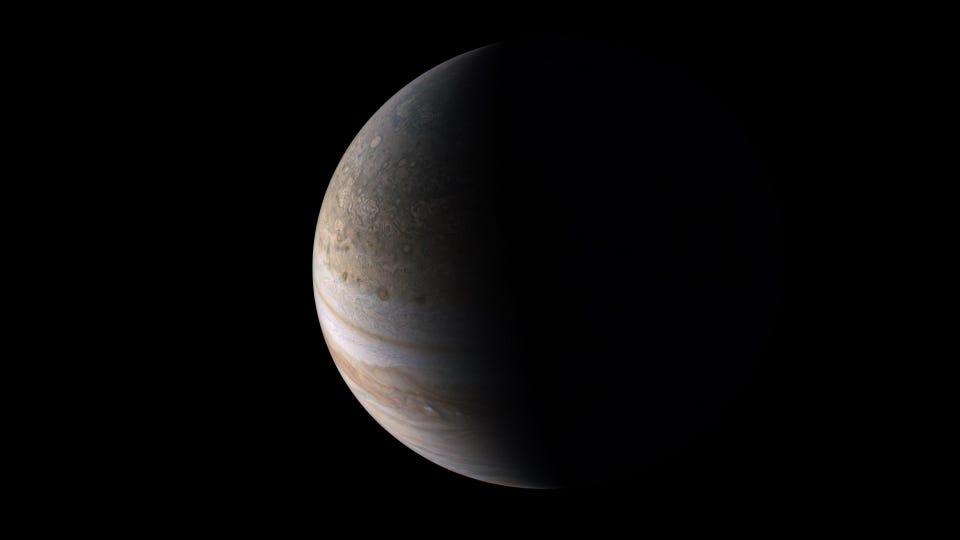Science In Photos: See The Spectacular New Images Of Jupiter And Its Swirling Storms Taken Last Week By NASA’s Juno Spacecraft Jamie Carter Senior Contributor Opinions expressed by Forbes Contributors are their own. I inspire people to go stargazing, watch the Moon, enjoy the night sky New! Follow this author to stay notified about their latest stories. Got it! Aug 20, 2022, 05:05am EDT | New! Click on the conversation bubble to join the conversation Got it! Share to Facebook Share to Twitter Share to Linkedin Jupiter as captured by NASA’s Juno spacecraft on its 44th perijove on August 17, 2022 and .
. . [+] post-processed by Kevin M.
Gill. NASA/JPL-Caltech/SwRI/MSSS/Kevin M. Gill © CC BY On Wednesday last week NASA’s Juno spacecraft looped around Jupiter for the 44th time.
As it did it took another set of jaw-dropping images of the giant planet. They were transmitted to Earth late last week and since then a team of citizen scientists have processed the data—and data showing Jupiter itself—into this stunning collection of images of its swirling storms and cyclones. Jupiter as captured by NASA’s Juno spacecraft on its 44th perijove on August 17, 2022 and .
. . [+] post-processed by Kevin M.
Gill. NASA/JPL-Caltech/SwRI/MSSS/Kevin M. Gill © CC BY In a long elliptical orbit of Jupiter since 2016, NASA’s $1.
1 billion Juno spacecraft’s latest flyby (called a perijove ) of Jupiter saw it dip close to the giant planet’s northern polar regions. Juno has done some incredible work at Jupiter that’s allowed scientists to learn a lot more about its complex interior whose origin is difficult to understand. Jupiter as captured by NASA’s Juno spacecraft on its 44th perijove on August 17, 2022 and .
. . [+] post-processed by Kevin M.
Gill. NASA/JPL-Caltech/SwRI/MSSS/Kevin M. Gill © CC BY “Juno has provided a complete overhaul of our understanding of Jupiter,” said Jonathan Lunine, a planetary scientist at Cornell University and co-investigator on the Juno mission.
“It has remarkable storms and atmospheric circulations and an intricate magnetic field. ” Recommended For You 1 New Research Finds A Connection Between Domestic Violence And These Two Personality Disorders More stories like this Fewer stories like this 2 This Scientist Helps Andean Forests And Ecuador’s Women In STEM More stories like this Fewer stories like this 3 Exceptional Fossil Preservation Suggests That Discovering Dinosaur DNA May Not Be Impossible More stories like this Fewer stories like this Jupiter as captured by NASA’s Juno spacecraft on its 44th perijove on August 17, 2022 and . .
. [+] post-processed by Kevin M. Gill.
NASA/JPL-Caltech/SwRI/MSSS/Kevin M. Gill © CC BY Now in its extended mission, the bus-sized spacecraft has had a slight adjustment to its orbital period. “Its basic elliptical orbit has been maintained and its close approach point to Jupiter has been migrating slowly northward,” said Lunine.
“One of the key goals for Juno at Jupiter is to get very close observations of the planet’s higher northern latitudes, which look very different from the lower latitudes. ” Jupiter’s northern cyclones as captured by NASA’s Juno spacecraft on its 44th perijove on August 17, . .
. [+] 2022 and post-processed by Navaneeth Krishnan S. NASA/SwRI/MSSS/Navaneeth Krishnan S © CC BY Although one of these image does include Jupiter’s volcanic moon Io, next month we’ll get to see some close-ups of Europa, the fourth-largest moon of Jupiter.
On September 29, 2022 it will get to just 221 miles/355 kilometers) above Europa’s surface just before its 45th perijove . Juno last made a distant encounter with Jupiter’s moon Europa in October 2021. Jupiter as captured by NASA’s Juno spacecraft and post-processed by Kevin M.
Gill. NASA/JPL-Caltech/SwRI/MSSS/Kevin M. Gill © CC BY Those images should be stunning.
Europa looks like a veiny eyeball moon because of the fractures in its icy surface. It’s got a thin oxygen-rich atmosphere, a layered inner structure including a liquid iron core and a magnetic field. Below its 11 mile/18 kilometer thick crust of ice there’s thought to be a global ocean of water.
It’s therefore a top target for NASA and others in their search for life off-Earth alongside Enceladus at Saturn . Jupiter and, top, its moon Io, as captured by JunoCan on August 17, 2022 from an altitude of 15,9298 . .
. [+] km. Post-processed by Brian Swift.
NASA/JPL-Caltech/SwRI/MSSS/Brian Swift © CC BY It’s hardly surprising, then, that two spacecraft—NASA’s Europa Clipper and the European Space Agency (ESA)’s Jupiter Icy Moon Explorer (JUICE)—are due to visit the moon in the early 2030s in the wake of Juno’s mission. Juno’s other remaining close flybys of Jupiter’s moons include the planet’s volcanic moon Io on both December 30, 2023 and February 3, 2024. Wishing you clear skies and wide eyes.
Follow me on Twitter or LinkedIn . Check out my website or some of my other work here . Jamie Carter Editorial Standards Print Reprints & Permissions.
From: forbes
URL: https://www.forbes.com/sites/jamiecartereurope/2022/08/20/in-photos-see-the-spectacular-new-images-of-jupiter-and-its-swirling-storms-taken-last-week-by-nasas-juno-spacecraft/



